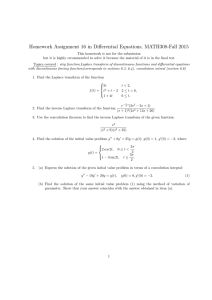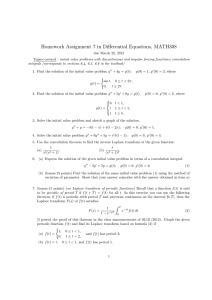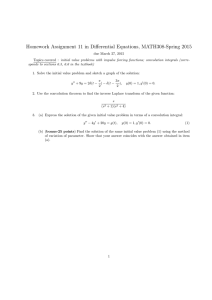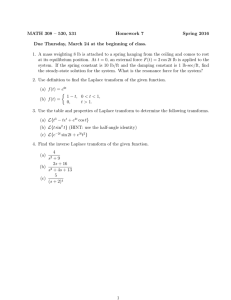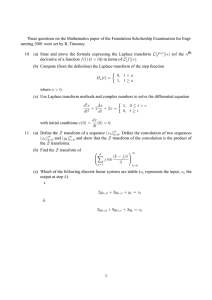Math 2250 Lab 10 Due December 4, 2014 Name:
advertisement
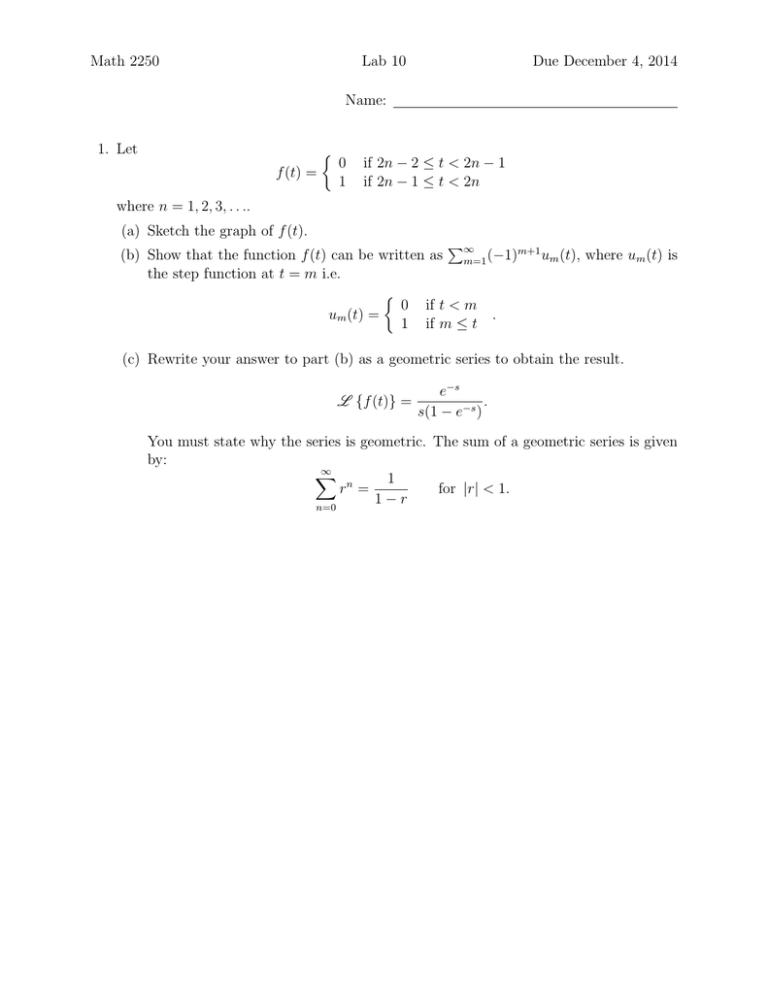
Math 2250
Lab 10
Due December 4, 2014
Name:
1. Let
f (t) =
0
1
if 2n − 2 ≤ t < 2n − 1
if 2n − 1 ≤ t < 2n
where n = 1, 2, 3, . . ..
(a) Sketch the graph of f (t).
P
m+1
(b) Show that the function f (t) can be written as ∞
um (t), where um (t) is
m=1 (−1)
the step function at t = m i.e.
0 if t < m
um (t) =
.
1 if m ≤ t
(c) Rewrite your answer to part (b) as a geometric series to obtain the result.
L {f (t)} =
e−s
.
s(1 − e−s )
You must state why the series is geometric. The sum of a geometric series is given
by:
∞
X
1
rn =
for |r| < 1.
1−r
n=0
Math 2250
Lab 7, Page 2 of 8
Due July 17, 2014
Math 2250
Lab 7, Page 3 of 8
Due July 17, 2014
2. Consider a physical system in which the output or response x(t) to an input function
f (t) is described by some differential equation of the form
ax00 + bx0 + cx = f (t)
for unknown parameters a, b, c determined by the system. Assume that you only know
that all inputs to this system x(t) satisfy
Z t
x(t) =
e−3τ sin(4τ )f (t − τ )dτ
0
for any forcing function f (t) and that this system is passive initially; that is, x(0) =
x0 (0) = 0. This is an example of Duhamel’s principle, which uses convolution to reduce
the problem of finding a system’s output for all possible inputs to a single inverse Laplace
transform.
(a) w(t) = e−3t sin(4t) is called the weight function of the system. Use this to find the
transfer function W (s), where w(t) = L −1 {W (s)}.
Math 2250
Lab 7, Page 4 of 8
Due July 17, 2014
(b) The transfer function, W (s), is the ratio of output x(t), to input, f (t) but in the
s–domain. That is
X(s)
W (s) =
,
F (s)
where X(s) = L {x(t)} and F (s) = L {f (t)}. Use these facts, and W (s) found
in part (a) to determine the left hand side of the nonhomogeneous ODE describing
your mechanical/electrical system.
If this was a mass, spring, damper system, what would the values of m, c and k be?
If it was an electrical system, what would the values of L, R and C be?
Hint: Do the Laplace transform method of solving ODEs in reverse. Your starting
point is X(s)/W (s) = F (s). Also, you were not given a specific function for F (s),
thus just assume F (s) = L {f (t)}.
Math 2250
Lab 7, Page 5 of 8
Due July 17, 2014
3. The transfer function in the previous question is also useful in the signal processing.
We now consider a system with the input signal f (t) and the output signal y(t). The
transfer function W (s) is again the ratio
W (s) =
Y (s)
,
F (s)
where F (s) = L {f (t)} and Y (s) = L {y(t)}. It is given that the transfer function
5e−τ s
W (s) =
,
1 + Ts
where τ = 0.2 and T = 2. Suppose f (t) is the constant unit function i.e. f (t) ≡ 1.
(a) Find the output signal y(t). (Hints: first compute Y (s) and then use the inverse
Laplace transform to find y(t).)
(b) Use either computer software or by hand to sketch the graph in (a).
(c) In part (b), you should notice that y(t) is zero in the beginning. The time that the
output signal y(t) starts to increase is called the time delay. Find the time delay.
(d) Find the time that the output signal y(t) reaches 63% of its steady value.
(e) How does the time delay change if the value of τ is increased? How does the time
in part(d) change if the value of T is increased?
Math 2250
Lab 7, Page 6 of 8
Due July 17, 2014
4. Consider an RLC Circuit with R = 125 Ω, L = 1 H, C = 0.0004 F, and a battery
supplying e0 = 75. Additionally, suppose I(0) = 0, I 0 (0) = 75. At time t = 0 the switch
is closed and at time t = 1 it is opened and left open. This circuit can be modeled by
LI 00 + RI 0 +
1
I = e0 (t)
C
where e0 (t) = −75δ(t − 1).
(a) The delta function δ(t − a) satisfies
Z ∞
f (t)δ(t − a) dt = f (a).
0
Using the definition of the Laplace transform, find L {δ(t − a)}.
(b) Find the resulting current I(t) in the circuit using Laplace transform methods.
Math 2250
Lab 7, Page 7 of 8
Due July 17, 2014
5. Convolution as a matrix multiplication:
Suppose a parallel resistor-capacitor (RC) circuit, with time-varying input current f (t)
has a voltage v(t) determined by the linear first-order DE:
C
1
dv
= − v + f (t).
dt
R
Taking the customary Laplace transform, with v(0) = 0, we get
V (s) =
1
C(s +
1 F (s).
)
RC
Using the convolution theorem, the voltage can be expressed as
v(t) = [f ∗ g](t),
t
where g(t) = C1 e− RC is the kernel function for the RC circuit. The convolution [f ∗ g](t)
is a special type of integral where two functions f (t) and g(t) defined on t ≥ 0 produces
a convolution product given by
Z t
[f ∗ g](t) =
f (τ )g(t − τ )dτ.
0
For a general input current f (t), this integral cannot be solved by analytical methods and
so we need a means of approximation that works for any f (t) we are given. Suppose that
we sample f (t) at small, equal length intervals ∆τ . That is ti = k∆τ for k = 0, 1, . . . n−1,
and we form an n-length vector f~ representing a “digital” version of our input:
T
f~ = f (t0 ) f (t1 ) f (t2 ) f (t3 ) . . . f (tn−1 ) .
Our goal is to produce a output vector of circuit voltages ~v
T
~v = v(t1 ) v(t2 ) v(t3 ) v(t4 ) . . . v(tn ) .
For a given ∆τ , it turns out that we can find a matrix A that functions as an approximation of the convolution integral:
~v = Af~.
Once A is found, any input f~ can be computed.
Rt
To generate A, recall that integration 0 h(τ )dτ can be approximated by a Riemann sum
by partitioning the interval from 0 to t into N equal-length segments ∆τ . The segments
are ∆τ = t/n,
Z b
n−1
X
h(a + k∆τ )∆τ.
h(τ )dτ ≈
a
k=0
Math 2250
Lab 7, Page 8 of 8
Due July 17, 2014
(a) We now specify some values: R = 6 Ω, C = 0.1 F, n = 6 and t = 3. (Note that
the main goal of this question is to give you an idea how the method works. In
general, the approximation works better for choosing n to be sufficiently large.)
Then ∆τ = 0.5, and t0 = 0, t1 = 0.5 and so on. Using the approximation of a
Rieman sum, we have
1
v(t1 ) ≈ f (t0 )g(t1 )
2
1
v(t2 ) ≈ (f (t0 )g(t2 ) + f (t1 )g(t1 ))
2
1
v(t3 ) ≈ (f (t0 )g(t3 ) + f (t1 )g(t2 ) + f (t2 )g(t1 ))
2
..
.
..
.
Write down the remaning (approximated) equations for v(t4 ), v(t5 ), v(t6 ) and then
write down the matrix A for this system.
(b) We now consider the function f (t) = 5 sin 0.8t. Find the approximated value of
v(3) by using (a) with an aid of computer software.
